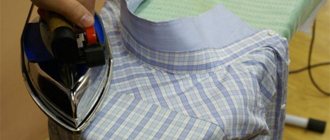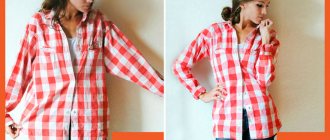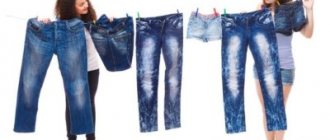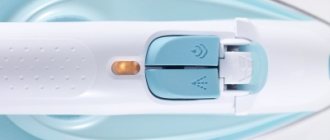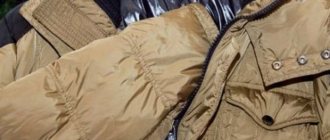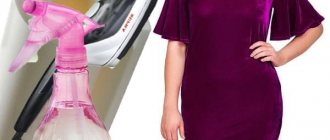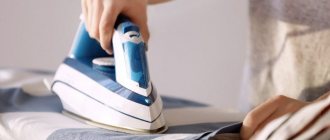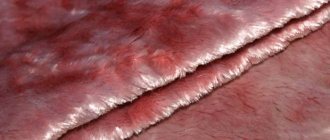Useful tips for ironing a men's shirt
To make the ironing process easier, the following recommendations are offered:
- When washing a product in a washing machine, you need to set it to the “Easy Iron” mode intended for shirts.
- It is advisable to dry the shirt on a hanger, having straightened it first. In this case, folds will not appear on it and the fabric will not wrinkle.
- It is advisable to iron the shirt while damp. To do this, you can resort to using a spray bottle. In the absence of one, it is advisable not to let the product dry too much.
- How to iron dark men's shirts correctly? It is recommended to iron such shirts from the wrong side, otherwise the fabric will soon lose color and become shiny. This rule also applies to products made from shiny fabrics.
- Each type of fabric needs its own ironing mode. An overheated iron will scorch or burn through your shirt. If the temperature is insufficient, it will be difficult to iron out “wrinkles”. Also, not all fabrics react equally to steam and moisture, so it is recommended to study the label on the product, which indicates care recommendations and the temperature setting of the iron.
- First, you should iron the cuffs, collar, then the sleeves and fronts, and finally iron the back.
Attention! You should not iron unwashed shirts, as unnoticeable dirt and stains after ironing will be firmly welded to the material and will be quite difficult to get rid of.
If you follow these simple recommendations, the ironing process will not seem difficult, and things will retain their presentation for a long time.
How to choose the right iron setting for different fabrics
Before ironing a shirt, check what materials are included in the fabric:
- silk or synthetics (polyester, viscose) are ironed at the lowest temperature setting of the iron, marked with one dot, which corresponds to 110-120 ℃. For severe bruises, it is recommended not to splash water, but to use steam in small quantities;
- cotton or wool require higher temperatures - 150-170 ℃, that is, the average heating mode of the iron, marked with two dots. Cotton will iron better if you add steam and apply firm pressure to the iron. Fabrics with added wool should be ironed through a damp cotton cloth or gauze;
- linen needs a large amount of steam and the maximum temperature of the iron (200-220 ℃), which is indicated by three points on the mode selection scale.
Ironing a man's shirt correctly is a responsible task that requires certain efforts and skills.
Having to regularly iron a shirt with a heavy iron is an unpleasant and outdated task for many. The emergence of new materials that do not require ironing, modern equipment (ironing presses and rollers, steam generators and steamers) is gradually freeing us from routine manual labor. But we believe that many women will agree that a man in an ironed shirt with ironed collars, pockets and cuffs looks truly well-groomed and confident. So think carefully before you categorically refuse to iron a man's shirt!
Necessary equipment for ironing
Ironing a men's shirt with both long and short sleeves will be easier if you prepare all the necessary equipment in advance. What does it include:
- Iron with non-stick coating and steam function. If you don’t have such an iron, you can use a spray bottle.
- Ironing board with a special small board designed specifically for sleeves. The presence of such a device greatly simplifies the alignment of the sleeve and allows you to avoid the formation of arrows. If you do not have a small board, you can put a towel in the sleeve to get rid of the arrows.
- Spare water for refilling the spray bottle.
- A light or white towel made of natural material, preferably cotton. It is used as a backing on an ironing board or a product is ironed through it to avoid the formation of water stains and loss of color.
How to choose the temperature when ironing a shirt
For optimal results, you need to consider that each type of fabric needs its own temperature and humidity level. If the composition of the fabric is unknown, it is advisable to iron it at a minimum temperature. When the fabric contains polyester, the iron must be heated to 100 degrees. It is not advisable to iron artificial materials with high steam; the mode is set to minimum.
Products made from viscose are ironed at 120 degrees with steam treatment. But it is advisable not to wet viscose with a spray bottle, as unsightly water stains will remain.
Shirts made from natural fabrics are ironed at a temperature of 150 degrees and with plenty of steam. The product, which contains cotton and linen, will be ironed at 170 degrees with steam. Linen is the toughest material; it needs to be processed at a maximum temperature of 200-220 degrees and with a lot of steam to straighten out existing wrinkles.
Silk shirts should not be wetted with water to prevent stains and should be ironed dry. For silk products, use a minimum temperature and process from the inside out so that the shirt does not become shiny.
Important! If there is no label on the product and the composition is not known, you need to set the minimum temperature, gradually increasing it until the shirt begins to smooth out well.
Basic recommendations
Before you start ironing, be sure to study the recommendations on the product label . An iron icon with one circle inside means that the fabric needs to be processed at a minimum temperature, two circles correspond to the average temperature, and three circles correspond to the maximum.
Remember that when ironing silk or synthetic items, it is recommended to refrain from using steam and use the most delicate setting. It is best to turn the shirt inside out and only then begin processing. The same applies to any dark fabric, on which shiny marks may appear on the front side when ironed.
You can purchase clothes from famous brands at low prices in the online store https://barbaru.ru/
Cotton clothing can be exposed to high temperatures and even steam shock. Linen fabric can be ironed at maximum speed and steam can also be used.
You can always find ironing recommendations on the labels
Experts do not recommend drying clothes with an iron - this causes significant stress to the fabric fibers and is damaged. Therefore, it is better to dry the shirt before ironing or leave it slightly damp. You can always wet the fabric using a water spray or selecting the steam mode.
Of course, the most convenient way to use an iron is on a special ironing board. Large boards often come with miniature ones, which are convenient to use for ironing long sleeves without creases.
To spend less time ironing, you need to make sure that the shirt does not wrinkle during drying. It’s best to hang your clothes on hangers after washing, so you don’t have to think about how to deal with creases.
Processing procedure for men's shirts
You should iron a men's shirt from the smallest details, moving on to the largest ones:
- Collar - first of all, the part of the product that is constantly in sight is ironed. You need to iron from the inside out, from the edge to the center, so as not to smooth out the folds in the corners of the collar. Next, turn it over to the front side and repeat the process. It is not advisable to iron along the fold, otherwise the collar will take on an ugly shape and lose its appearance. It is no longer possible to disguise such an oversight.
- Cuffs – you need to iron the sleeves starting from this part. The process is similar to processing a collar. The cuffs are unbuttoned and straightened on the board to avoid the formation of arrows, the double parts are unfolded, processed in a straightened form, folded and ironed along the fold.
- Sleeves - then we move on to the more complex part. It is important here that smoothed arrows do not appear, as they are indicators of poor taste. The sleeves should always be perfectly straight; to do this, straighten the fabric on the board, folding it in half, focusing on the seam. It is recommended to process the part from the shoulder to the cuffs, but do not go to the edge so that arrows do not appear. After ironing the sleeve on one side, it should be lifted and unfolded so that the seam is located at the bottom and in the middle. The rest is processed next. Repeat the operation with the other sleeve. For the process it is convenient to use a small special. board, but if you don’t have one, you can use a rolled up towel, which helps avoid the formation of arrows and speeds up the processing process.
- The fronts are the front parts of the shirt. You need to start from the side where the buttons are located, processing the area around them. Ironing over the top will leave an unsightly mark on the buttons. The direction of the iron is from the shoulder, up and down. Pockets are ironed from bottom to top to prevent wrinkles.
- The back is a voluminous, but simpler part of the shirt. Lay out the shirt on the board so that one of the sleeves is located near the long edge of the board. The direction of the iron is from top to bottom, from the shoulders to the edge. After ironing one half, position the shirt so that the second sleeve is near the edge of the ironing board. The remaining unironed part is processed at the end.
- Inspection is the final stage of ironing, during which you should make sure that all areas are ironed. If folds are found, they should be processed again.
After completing the work, you can put the product on or hang it on a hanger, having first fastened the top button.
Ironing process
Next, you can proceed to the algorithm of how to properly iron a shirt.
- You always need to start with small details. Most opinions boil down to the fact that you should start with the collar of the shirt.
- To do this, you need to unfold the shirt and iron the collar from the inside. Immediately pay attention to details: in this case, the buttons on the collar or the collar itself.
- Turn over and iron right sides, insert clips. Iron the trace, and this completes the work with the collar.
- To iron shirt sleeves correctly, start with the cuff - these are double parts, like the collar, and should not be put off until later. We repeat the same steps as with the collar, but unlike it, the fabric of the cuff is not reinforced from the inside, so it is better to iron them in the middle so as not to wrinkle.
Then connect the cufflink loops and iron the cuffs. Then it needs to be folded and ironed while folded, being careful not to create cuffs along the edges.
- Fold the sleeve exactly along the seam and iron from the shoulder to the cuff. It is important not to iron the sleeves close to the edge, and then spread it out so that the seam is at the bottom. This shows how to iron a shirt without arrows. Most ironing boards have a special attachment for ironing shirt sleeves; if you don't have one, you can use a towel roller.
- Next, we iron the shelves: the side with buttons, going around them, passing from top to bottom, then the side with loops. Buttons are made of plastic and can melt even if they don't, ironing buttons creates unsightly creases in your shirt. The pocket, on the contrary, needs to be ironed strictly, from bottom to top.
- The back is one of the simplest parts, so we finish ironing the shirt with it. It is important to lay out the shirt evenly, then there is nothing difficult about ironing the back. You need to iron from shoulder to edge.
- Check if there are any folds left, if not, then the shirt is ready!
- In addition to the iron, many people use other devices for ironing. Ironing shirts with a steamer is not so effective, but a steam generator can be a great help.
Ironing a long sleeve shirt without an iron
Situations arise when you need to iron a shirt, but there is no way to use an iron. For example, the electricity has been cut off, the iron has broken down, and your shirt urgently needs to be ironed, or you need to get your clothes in perfect shape on the train before leaving the platform. There are several proven ways to iron a product in such situations:
- With wet hands. To do this, you need to lay the shirt out on the table, wet your hands and sweep the fabric with a sharp movement, as if shaking it off. Then you need to shake the product vigorously and hang it on hangers to dry or dry it with a hairdryer.
- Steam bath. Hang the product on a hanger in the bathroom, turn on the hot water and close the door to the room for 30 minutes. During this time, the shirt will be smoothed under the influence of steam. It is advisable that splashes of hot water do not fall on the material, otherwise stains and unevenness will form.
- On myself. Partially or completely spray the fabric with a spray bottle, put on the shirt and dry it on yourself. Under the influence of heat emanating from the body, the moisture will quickly dry out and the fabric will take on the desired shape.
- Using leveling solution. You need to pour the same amount of laundry softener, water and table vinegar into the spray bottle. Shake the mixture and spray onto the crumpled fabric. This method is not suitable for delicate and synthetic items, as stains remain on the fabric after treatment.
Attention! Before ironing the fabric, you need to wash your hands thoroughly, otherwise even minor dirt on your hands will transfer to the fabric.
Neat clothes without ironing
If you don’t want to waste time using an iron, you can use alternative ways to wear neat and ironed clothes. Knowing the composition of the fabric, you can estimate the degree of its wrinkleability.
Natural fabrics such as linen, natural silk, muslin, cambric are prone to the rapid appearance of untidy creases.
Clothing with synthetic fibers retains its shape longer and is easily smoothed out after washing if clothes made from it are dried on hangers or flattened on a flat surface.
Denim
Denim is a coarse, stiff, dense twill fabric that Levi Strauss used to sew the first classic jeans. They sew from it:
- trousers,
- shirts,
- jackets,
- dresses and other things
There are many reasons for their popularity, one of which is: you don't need to iron them! This is a dense material that is resistant to deformation and retains its shape.
Crash
This fabric has a small fold, with an initially wrinkled effect. It makes stunning shirts!
Modern equipment for ironing shirts
Irons that produce steam and spray water have been replaced by new progressive achievements:
- Steam generator - the essence of the device is similar to an iron, but the difference between a steam generator and an iron is that this device is able to smooth out even heavily wrinkled fabric due to the continuous flow of a powerful jet of dry steam.
- Steamer - an intense stream of hot steam can cope with wrinkled folds, disinfect and eliminate odors from the material, and give things a neater and fresher look. Clothes can be processed in a vertical position and without the use of an ironing board.
- Steam mannequin is an inflatable mannequin that effectively dries and smooths sweaters and shirts.
- A steam cabinet is a device that also dries and smoothes any items, including shirts, and gives things a fresh look thanks to hot steam treatment.
Statistics show that many males do not know how to properly iron shirts, as they consider it women's work. But sometimes even an experienced housewife cannot always cope with such a task, because no matter how you put the shirt down, creases, arrows and folds will still form. The simple tips listed in the article will help you iron a men's shirt quickly and efficiently.
